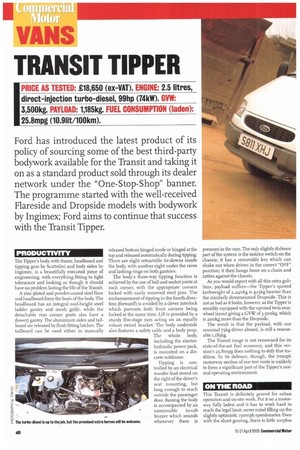TRANSIT TIPPER
Page 42

Page 43

If you've noticed an error in this article please click here to report it so we can fix it.
IPRICE AS TESTED: £18,650 (ex-VAT). ENGINE: 2.5 litres, direct-injection turbo-diesel, 99hp (74kW). °VW: 3,500kg. PAYLOAD: 1,1854. FUEL CONSUMPTION (laden): 25.8mpg (10.91it/100km). Ford has introduced the latest product of its
policy of sourcing some of the best third-party bodywork available for the Transit and taking it on as a standard product sold through its dealer network under the "One-Stop-Shop" banner.
The programme started with the well-received Flareside and Dropside models with bodywork by Ingimex; Ford aims to continue that success with the Transit Tipper.
PRODUCTIVITY
The Tipper's body, with frame, headboard and tipping gear by Scattolini and body sides by I ngimex, is a beautifully executed piece of engineering, with everything fitting to tight tolerances and looking as though it should have no problem lasting the life of the Transit.
A zinc-plated and powder-coated steel floor and headboard form the basis of the body. The headboard has an integral roof-height steel ladder gantry and mesh grille, while the detachable rear comer posts also have a (lower) gantry The aluminium sides and tailboard are released by flush fitting latches. The tailboard can be used either in manually released bottom hinged mode or hinged at the top and released automatically during tipping. There are eight retractable tie-downs inside the body, with another eight under the raves and lashing rings on both gantries.
The body's three-way tipping function is achieved by the use of ball-and-socket joints at each corner, with the appropriate corners locked with easily removed steel pins. The embarrassment of tipping in the fourth direction (forward!) is avoided by a clever interlock which prevents both front corners being locked at the same time. Lift is provided by a sturdy five-stage ram acting on an equally robust swivel bracket. The body underside also features a safety cable and a body prop. The whole body, including the electi-ohydraulic power pack, is mounted on a discrete subframe.
Tipping is controlled by an electrical wander lead stored on the right of the driver's seat mounting, but long enough to reach outside the passenger door. Raising the body is accompan led by an unmissable in-cab buzzer which sounds whenever there is pressure in the ram. The only slightly dubious part of the system is the isolator switch on the chassis: it has a removable key which can shake out when driven in the correct "OFF" position; it then hangs loose on a chain and rattles against the chassis.
As you would expect with all this extra gubbins, payload suffers—the Tipper's quoted kerbweight of 2,240kg is 425kg heavier than the similarly dimensioned Dropside. This is not as bad as it looks, however, as the Tipper is sensibly equipped with the uprated twin-rearwheel layout giving a GVW of 3,5ookg, which is 200kg more than the Dropside.
The result is that the payload, with our nominal 75kg driver aboard, is still a reasonable 1.185kg.
The Transit range is not renowned for its state-of-the-art fuel economy, and this version's 25.8mpg does nothing to defy that tradition. In its defence, though, the 70mph motorway section of our test route is unlikely to form a significant part of the Tipper's normal operating environment.
ON THE ROAD
This Transit is definitely geared for urban operation and on-site work. Put it on a motorway fully laden and it has to work hard to reach the legal limit, never mind filling up the slightly optimistic isomph speedometer. Even with the short gearing, there is little surplus
power available from the 99hp engine. Some allowance must be made for the fact that our test vehicle had covered just 1,500 miles since leaving the production line, but we look forward with keen anticipation to the new ri5hp engine which is promised for this summer.
Where the Transit does score is in the manner of its power delivery. Typical of Ford's turbo-diesels, its power is produced so seam
lessly that you need to look under the bonnet to check there really is a turbocharger fitted. Also typical, mind you, is the noise output, which still lags behind current standards. Fortunately, that tightly constructed body doesn't contribute at all to the noise levels.
The Transit's excellent visibility arid good turning circle make it ideal for manoeuvring in confined builders' yards, while the twin rear wheels should help with sensible off-road duties. The ride and handling are the usual welldeveloped and vicefree Transit package.
The Transit Tipper is supplied with a fairly basic cab specification. Instrumentation is limited to the basic three, plus a clock. A very simple radio/cassette is fitted, with just three pre-set buttons and the bare essential controls looking lost on the giant face plate. Windows are manually wound, but all this is made up for by the magnificent driver's throne, with its integral armrests and pneumatic lumbar support. All three occupants get lapand-diagonal seat-belts.
SUMMARY
The Transit Tipper may look expensive when compared with some of its competitors, but you do get the versatility of a three-way tipping body with build quality as good as any. Add in the convenience and backup that should come with buying a complete package from your Ford dealership, and that extra investment begins to look more palatable. But for our money, those extra horses galloping to the rescue can't arrive a moment too soon.
• by Colin Barnett












































































































